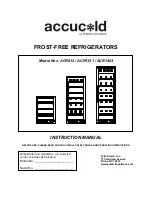
Operation
Seite GB-13
food cannot be contaminated by sal-
monella or similar bacteria.
■
Abide by the storage times recom-
mended by food manufacturers.
■
Note that the shelf life of the frozen
food may be shortened due to a rise
in the temperature inside the appli-
ance (from defrosting, cleaning or
power failure).
■
In case of prolonged power failure
or appliance malfunction, remove
stored frozen food from the appliance
and store it in a suffi ciently cool place
or in another refrigerating appliance
maximum storage time.(see "Product
fi che concerning Regulation (EU) Nr.
1060/2010“ on page GB-28)
■
After a malfunction, check wheth-
er the stored food is still edible. Con-
sume thawed and defrosted foods
immediately, do not refreeze.
Risk of injury!
Improper handling of the appliance
may result in injury. Risk of burns caused
by low temperatures.
■
The food and the inside walls of the
freezer compartment have a very low
temperature. Never touch them with
wet hands. This can cause injury to
the skin. Skin damage can occur even
with dry skin.
■
Let ice cubes or ice lollies thaw a lit-
tle before eating, do not put into your
mouth straight from the freezer com-
partment.
If there is not enough space in the
freezer compartment, you can remove
the shelf.
Freezing food
Freezing means reducing the core tempera-
ture of fresh, room-temperature food to fro-
zen as quickly as possible – for best results
“flash-frozen”. If not cooled quickly enough,
the food will be “killed by frost”, i.e. the struc-
ture will be destroyed. A constant storage
temperature of -18° C is needed to maintain
the food’s consistency, taste and nutritional
value.
Preparing food
• Only freeze high quality food.
• Freeze fresh and prepared food dry and
unseasoned. Unsalted foods are more
durable.
• Allow prepared food to cool before freez-
ing. This not only saves power, but also
prevents excessive frost formation in the
freezer area.
• Carbonated drinks are not suitable for
freezing because the carbon dioxide es-
capes during freezing.
Suitable packaging
Packaging is important when freezing. This
will protect against oxidation, penetration by
microbes, transfer of odours and flavourings
and drying out (freezer burn).
• Only use packaging material that is
strong, impermeable to air and liquid, not
too stiff and labelled. It should be desig-
nated as suitable for freezer use.
Portions
• Create flat portions if possible; these
freeze through to the core faster.
• Expel the air from the freezer bag as this
causes the contents to dry out and takes
up space.
• Use plastic clips, rubber bands or adhe-
sive tapes to seal.
• Fill liquid containers no more ¾ full, be-
cause liquids expand when frozen.
















































